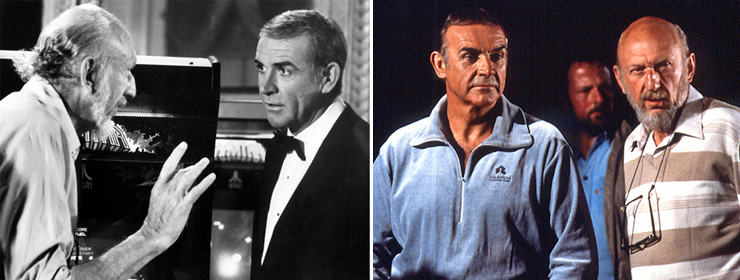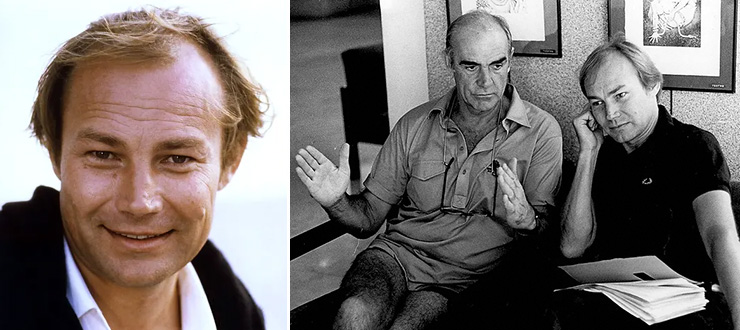|
Never Say |
||
|
||
|
Never Say |
||
|
||
 |
|
Kershner accepted Connery and Schwartzman’s challenge and was magnanimous regarding Connery’s importance in the 007 role; “Sean Connery is the real James Bond. I wouldn’t have been interested in making a Bond film but I felt there is a mystique to Sean playing Bond. To have him come back to the role after 12 years presented a great challenge for me. As far as I’m concerned there have been no Bond films since Sean made Diamonds Are Forever. There have been some other pictures made about a guy called James Bond.” Kershner was later quoted in the film’s official production notes, “I looked at some of the older films and realised which ones I liked and which ones were not up to par. I decided to forget I had seen any of them. As far as I’m concerned, there never was a Bond picture before.” A dangerous mistake to make, and very probably one of the major reasons the film failed to live up to an EON-produced Bond movie. |
|||
|
|||
|
With a director signed, and a writer working on a screenplay, Never Say Never Again continued to steer its way through a legal minefield, and was well on its way to becoming the first serious non-official Bond film. It appeared that the film’s director/screenwriter relationship was off to a bad start. Semple Jr commented, “Kersh is the most notorious destroyer of scripts in Hollywood… Quite a few people in Hollywood turn white at the very thought of Kersh becoming involved with a project. His habit is to immediately say the script is terrible and start re-writing it himself.” Kershner defended himself, “I came onto the project with a script, which had been designed to satisfy a contract more than an audience.” |
|||
 |
|||
|
As the screenplay progressed, the atmosphere on Never Say Never Again became tense. It would seem evident that Kershner’s arrival on the film prompted Semple Jr’s departure. After abandoning the screenplay Semple Jr lost interest in the movie’s fate. “I made a point of not hearing a word about it,” he confessed. Although he added, “I would love it to be a hit… I really don’t want to be known as the man who finally wrote a James Bond flop.” Never Say Never Again’s screenplay needed careful doctoring before it was finally green-lighted by Sean Connery. During a Guardian lecture at the National Film Theatre in London in December 1983, he explained, “Unfortunately Lorenzo is American, and the humour is very British, with an American director and an American writer it had a tendency to go towards American humour.” Connery brought in British TV sitcom writers Dick Clement and Ian La Frenais to tweak the dialogue and integrate the British humour, for which the Bond films have always been renowned. The duo injected many of the pithy one-liners, and Connery was said to have been delighted with their work. He told Gloria Hunniford on the TV programme Sunday Sunday in 1983, “… without them the picture wouldn’t be half as good in terms of dialogue. They really should have had more credit than they have.” Connery was later annoyed to discover that a Writer’s Guild of America restriction prevented them from receiving a screen credit. Clement and La Frenais admitted that the, “Fill this beaker!” “From here?” gag, exchanged between Bond and a Shrublands nurse, was in fact a recycled joke from their BBC TV comedy series Porridge. |
|||
 |
|||
|
One element for which Never Say Never Again cannot be faulted is its rich and colourful international cast, for which Sean Connery was also largely responsible. Schwartzman commented in the film’s production notes, “When Sean and I first shook hands on the deal we said ‘Let’s be honest with each other. If at any time we see the quality of the film eroding, let’s call it off. Let’s really go for something of a very high standard, and start by casting it in a way we’ll be proud of. And that’s exactly what we did.” Connery pushed hard to sign Klaus Maria Brandauer for the role of Maximillian Largo. “Klaus Maria Brandauer is unquestionably one of the best actors in Europe, if not the world,” Connery said in the film’s publicity notes. Never Say Never Again was the first English-speaking picture in which Brandauer appeared. The Austrian actor had won international acclaim after appearing in Istvan Szabo’s Mephisto, which won the 1982 Academy Award for Best Foreign Film. |
|||
|
Max Von Sydow (1929-2020) was cast as Blofeld, the character’s first ‘official’ appearance since 1971’s Diamonds Are Forever. “Another fine actor,” commented Connery. A cinematic icon, Sydow is probably best known for his starring roles in Ingmar Bergman’s The Seventh Seal (1957) and William Friedkin’s The Exorcist (1973). Irvin Kershner found Barbara Carrera for the deadly temptress, Fatima Blush. It’s interesting to note that the name Fatima Blush was actually lifted from one of the original early ‘Thunderball’ screenplays by Ian Fleming, Jack Whittingham, and Kevin McClory. Kim Basinger was ‘discovered’ by Mrs Connery following an encounter with the actress in London’s Grosvenor House Hotel. Basinger followed Never Say Never Again by becoming an international star, appearing in such box-office hits as Batman (1989) for Tim Burton and Curtis Hanson’s adaptation of James Ellroy’s L.A. Confidential (1997), for which she won an Academy Award for Best Actress in a Supporting Role. |
|||
|
|